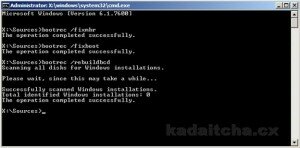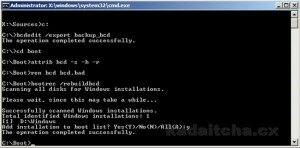Microsoft calls the Command Prompt in the System Recovery Options “the Windows Recovery Environment (Windows RE)”. In this article we call it what it is, a command prompt.
If you need instructions on starting the recovery tools there is a step by step guide here. Once the System Recovery Options menu is displayed click Command Prompt:
In this article you will be using a tool called Bootrec.exe to repair A) a corrupt master boot record (MBR), B) a damaged boot sector or C) Windows 7′s Boot Configuration Data (BCD) store.
The simplest way to try and fix your startup problem is to issue these three commands in succession:
bootrec /fixmbr
bootrec /fixboot
bootrec /rebuildbcd
Type the first command then press enter; wait until the process completes before moving onto the next command:
At this point your OS should boot normally. If it doesn’t then you will have to backup the BCD store and rebuild it from scratch. Enter these commands, one after the other, to backup and rebuild the BCD:
c: bcdedit /export backup_bcd cd boot attrib bcd -s -h -r ren bcd bcd.bad bootrec /rebuildbcd
Exit the command prompt, remove any startup DVD and reboot the machine.
Additional Information on BCDEDIT
From the BCDEDIT help text.
BCDEDIT - Boot Configuration Data Store Editor
The Bcdedit.exe command-line tool modifies the boot configuration data store.
The boot configuration data store contains boot configuration parameters and
controls how the operating system is booted. These parameters were previously
in the Boot.ini file (in BIOS-based operating systems) or in the nonvolatile
RAM entries (in Extensible Firmware Interface-based operating systems). You can
use Bcdedit.exe to add, delete, edit, and append entries in the boot
configuration data store.
For detailed command and option information, type bcdedit.exe /? <command>. For
example, to display detailed information about the /createstore command, type:
bcdedit.exe /? /createstore
For an alphabetical list of topics in this help file, run "bcdedit /? TOPICS".
Commands that operate on a store
================================
/createstore Creates a new and empty boot configuration data store.
/export Exports the contents of the system store to a file. This file
can be used later to restore the state of the system store.
/import Restores the state of the system store using a backup file
created with the /export command.
/sysstore Sets the system store device (only affects EFI systems, does
not persist across reboots, and is only used in cases where
the system store device is ambiguous).
Commands that operate on entries in a store
===========================================
/copy Makes copies of entries in the store.
/create Creates new entries in the store.
/delete Deletes entries from the store.
/mirror Creates mirror of entries in the store.
Run bcdedit /? ID for information about identifiers used by these commands.
Commands that operate on entry options
======================================
/deletevalue Deletes entry options from the store.
/set Sets entry option values in the store.
Run bcdedit /? TYPES for a list of datatypes used by these commands.
Run bcdedit /? FORMATS for a list of valid data formats.
Commands that control output
============================
/enum Lists entries in the store.
/v Command-line option that displays entry identifiers in full,
rather than using names for well-known identifiers.
Use /v by itself as a command to display entry identifiers
in full for the ACTIVE type.
Running "bcdedit" by itself is equivalent to running "bcdedit /enum ACTIVE".
Commands that control the boot manager
======================================
/bootsequence Sets the one-time boot sequence for the boot manager.
/default Sets the default entry that the boot manager will use.
/displayorder Sets the order in which the boot manager displays the
multiboot menu.
/timeout Sets the boot manager time-out value.
/toolsdisplayorder Sets the order in which the boot manager displays
the tools menu.
Commands that control Emergency Management Services for a boot application
==========================================================================
/bootems Enables or disables Emergency Management Services
for a boot application.
/ems Enables or disables Emergency Management Services for an
operating system entry.
/emssettings Sets the global Emergency Management Services parameters.
Command that control debugging
==============================
/bootdebug Enables or disables boot debugging for a boot application.
/dbgsettings Sets the global debugger parameters.
/debug Enables or disables kernel debugging for an operating system
entry.
/hypervisorsettings Sets the hypervisor parameters.



thanks a lot this worked perfectly